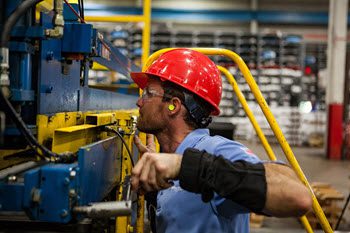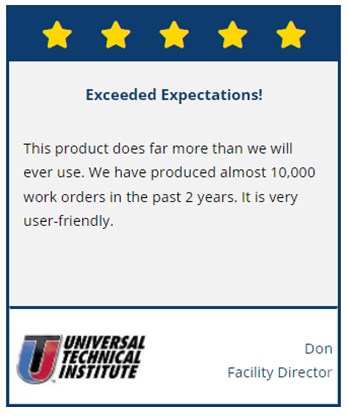 If you own any machines or equipment, breakdowns are inevitable and always costly. No matter what type of business you are in, you need to keep production operating with minimal to no disruptions.
If you own any machines or equipment, breakdowns are inevitable and always costly. No matter what type of business you are in, you need to keep production operating with minimal to no disruptions.
The impact on your business from neglected tasks or poor maintenance can bring your business to a halt. Simple tasks like lubricating parts, replacing minor components, and paying and scheduling the staff to complete maintenance tasks are more valuable than having the long-term costs you’ll suffer through emergency service for unexpected breakdowns. You are not only putting a stain on your equipment but also on your workers.
The first thing to avoid equipment breakdowns is to review the history of your operational maintenance program so that you can identify a pattern of events. This is the time to look deeper into all of the issues because big problems are often caused by small, preventable oversights. Overlooking the small issues that result in accidents, operational losses, and production setbacks are caused by poor maintenance and internal communication failures.

Unexpected equipment failures not only take your equipment out-of-service, but also have an impact on your resources, lost productivity, and production. Below we are going to highlight some of the ways in which overworked machines can affect your overall productivity and how you can prevent it using Computerized Maintenance Management System (CMMS) software.
Importance of Not Overworking Your Equipment
You have invested a lot of money in your equipment; you want to keep it running at peak performance for a long time. But, overextending your equipment can lead to extensive wear and tear. This wear and tear reduces the power and efficiency as well as can cause major damage beyond repair. Constantly running your equipment at full capacity and ignoring maintenance will eventually cause unexpected breakdowns and disruption to your business operations.
It is so important to keep accurate repair records and preventive maintenance schedules so as the equipment is approaching the end of its life, you can take the necessary steps to reduce the stress on the equipment so that you can extend the equipment’s lifespan, not overwork them and avoid unnecessary downtime.
Signs That You Are Overworking Your Equipment
Machine Overheats
- When equipment is continuously running, sometimes they are bound to overheat. If you don’t schedule some breaks, this can cause the equipment to perform at unacceptable levels or completely malfunction.
- Continually running overheated equipment puts a lot of stress on the equipment and the components need to keep the equipment running like lubricants, oils, hoses, and seals.
Avoid Overheating With Routine Preventive Maintenance Inspections
- The best way to prevent overheating is to ensure that preventive maintenance is scheduled and completely perfumed to make sure that equipment is properly maintained. To prevent equipment breakdowns, it is essential to schedule routine inspections to proactively identify and fix the problems before they become something that can cause a major disruption to your business. To effectively manage the wear and tear of equipment involves a mix of maintenance tasks and bringing in specialized technicians when necessary. Some things to check:
- Create a maintenance checklist like the one in this article: Preventive Maintenance Checklists – Important Tasks You Need To Include
- Check fluids to make sure that they are not low and changed at the appropriate manufacturer’s time.
- Gears and fitting are kept lubricated.
- Seals and hoses are all checked and changed as they are showing signs of excessive wear.
- Check the critical parts of the system to make sure they aren’t starting to degrade or look like they are going to go bad.
Having a regular routine preventive maintenance schedule and checklists will keep your equipment running longer and minimize downtime due to poor maintenance. Having a system like a CMMS will help you streamline and manage all of these processes.
Warning Lights
With the need to keep equipment working, it is so easy to ignore warning lights that seem so annoying. These warning lights are there for a reason and should not be ignored. They’re connected to sensors that alert you when things are not operating properly, ignoring them or putting electrical tape to cover them over doesn’t make the problem go away. In fact, you are putting your equipment at more risk and greater danger of breaking down.
Continually operating the equipment in this condition, the sensors will eventually burn out or stop working. This means that you are still operating a piece of equipment that has issues and may break down at any time, which can cause you a lengthy and expensive repair by ignoring the warning light. This also is a safety hazard and the operator of the equipment can be hurt due to unsafe equipment.
Ignoring warning lights can lead to serious equipment issues and expensive repairs. Having all of your equipment information, manuals, repair records, spare parts inventory, etc. stored in a computerized maintenance management system will provide you with the necessary information on when to make repairs and what repairs have already been made. All of this information can be accessed from a computer, Smartphone, or mobile device, no matter where you are located.
Frequent Breakdowns
Let’s face it equipment breakdowns will eventually happen, but with proper preventive maintenance, you can minimize the breakdowns, extend the lifespan of your equipment and minimize costs.
Loss in Productivity
In many manufacturing processes, one piece of equipment may be dependent on another, which means if one piece of equipment fails, production stops. Unexpected equipment breakdowns from overworking them can stop production, and poses a safety hazard for your employees. If a worker is on the equipment or near it, the malfunctioning machine may come to an abrupt halt and cause serious injury to an employee.
We all know that quotas are important but lost time due to equipment failure or an employee getting hurt is far more damaging to your business.
Keeping equipment in good working condition is essential and takes a little work to set up the appropriate preventive maintenance schedule for each piece of equipment. Maintenance schedules depend on the manufactures recommendations, equipment usage, age of the equipment, etc. All equipment in your facility requires maintenance but some may require unique or specific maintenance tasks on a regular basis. You need to identify these special pieces of equipment and include them in your routine maintenance plan. Not identifying and not having a schedule for each piece of equipment can cause major breakdowns and other problems.
Heavy Equipment Changes in Exhaust
A piece of heavy machinery’s exhaust can be a reliable sign that something is wrong. When an engine initially starts up, the normal exhaust is colorless or occasionally has a white tint from condensation in the pipes. But when the hue starts to alter, it is time to look into it more deeply. The presence of water or coolant entering the combustion chamber might be indicated by the presence of thick white smoke in the exhaust. Black smoke is a warning that the engine is burning too much fuel, while blue smoke could indicate an internal oil leak. It is a good idea to promptly identify the issue if you notice a change in the exhaust before it causes more harm.
Equipment Sounds
Operating equipment you become accustomed to the sounds that it makes. Listen to the sounds that are out of place, such as hisses, rattles, or bangs that simply are not standard for that piece of equipment. This small unusual sound might manifest into something more complicated or expensive to fix.
Communications
Poor communication is one of the biggest issues and can be the most costly. Making sure that all operators are aware of the warning signals and what to do if an issue emerges is one of the most important things you can do to ensure success. It may cost you a little more to take those breaks so machines don’t overheat, but if they do overheat, you are looking at a lot of lost time and expensive repairs. Taking chances like that simply isn’t worth it.
How to Prevent Equipment Failure
Equipment inevitably ages, corrodes, and deteriorates. However keeping on top of maintenance can minimize equipment breakdowns, business disruptions, and expenses. Some key things to help you avoid overworked machines and minimize downtime:
- Do a visual inspection and pay attention to any issues of deterioration or corrosion or unusual sounds. Make sure that you quickly address them before they become major issues.
- Don’t ignore warning lights or alarms.
- Create preventive maintenance schedules and repairs for all of your equipment, and do not ignore the schedules.
- Create routine inspections during off-peak hours to identify and fix any issues that could cause your equipment to go down.
- Operate equipment properly from start to shut down.
- Keep track of repair history and know when machines are aging and may require additional maintenance, repairs, or replacement.
Keeping Your Maintenance Tasks on Track
When having a lot of equipment, maintenance management can be complex and timely without the right tools to capture repair data and remind you of all of the hundreds of tasks. Today everyone wants to work faster, more efficiently, and at a reasonable cost. They want tools that are reliable and easy to use. Most maintenance managers are now on-board with Computerized Maintenance Management System (CMMS) software solution.
Your spreadsheets or pieces of paper are costing you a lot of time and money. It is easier than ever to get yourself up to speed on CMMS software, and you can have the confidence that you’re using a tool completely tailor-made to manage your maintenance operations more efficiently and minimize that unexpected downtime.
Other Articles
Conveyor Belt Maintenance Checklist – Things You Shouldn’t Forget
Overhead Crane Issues And How To Avoid Them
Preventive Maintenance Checklists – Important Tasks You Need To Include